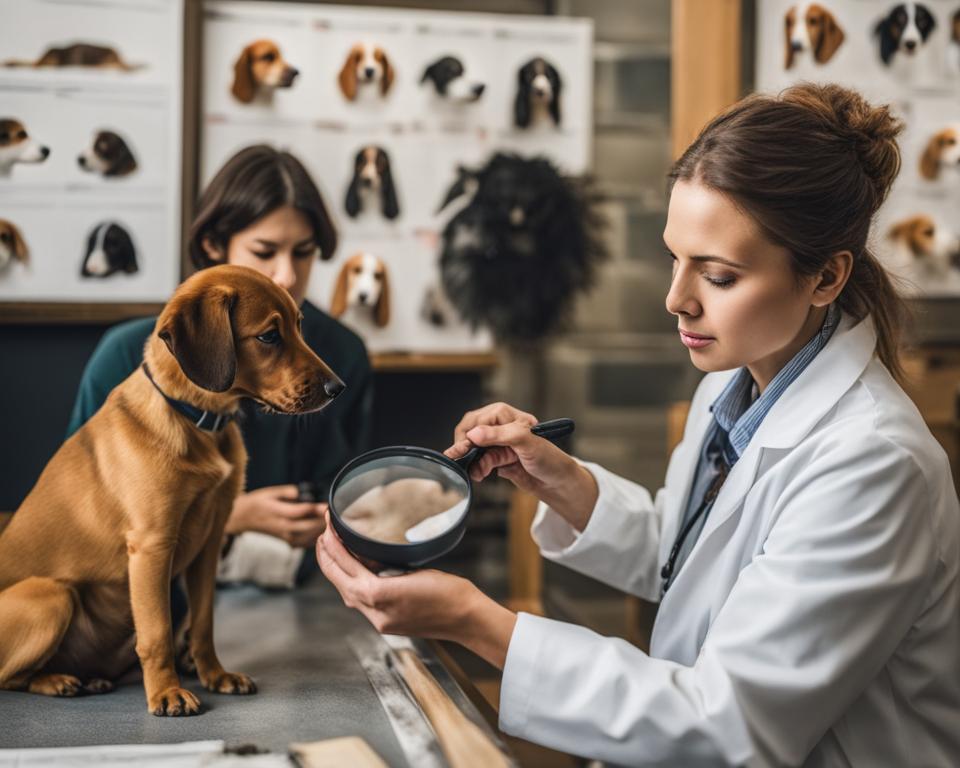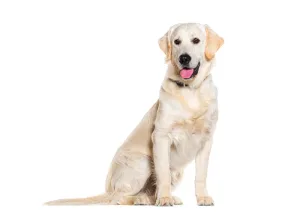Why Does My Dog Stare at Me: As a responsible pet owner, I’ve often found myself pondering the question: Why does my dog stare at me? It’s a behavior that has intrigued dog owners for centuries, and understanding the meaning behind it is crucial for interpreting our furry friends’ behavior and strengthening the bond between us.
When it comes to dog behavior, there’s more than meets the eye. Canine body language and pet psychology play important roles in deciphering what our dogs are trying to communicate through their intense gaze. By examining their body postures, facial expressions, and different scenarios, we can unravel the mystery behind our beloved companions’ staring behavior.
Understanding dog communication is not only fascinating but also practical. It allows us to interpret our dogs’ needs, emotions, and desires more effectively. Whether it’s a longing for attention, a request for a walk, or a sign of discomfort, our dogs look to us to understand and fulfill their needs.
Key Takeaways:
- Staring is a form of communication that dogs use to express their needs, emotions, and desires.
- Interpreting dog body language and understanding canine behavior is crucial in unraveling the meaning behind their gaze.
- Staring can indicate various things, such as seeking attention, anticipating activities, or expressing discomfort.
- Building a strong dog-human connection requires recognizing and responding to their staring behavior.
- Training and positive reinforcement can help shape and redirect their staring behavior to ensure a harmonious relationship between you and your dog.
What’s Some Common Dog Body Language?
Dogs are highly communicative animals, and they use body language as a primary means of expressing themselves. Understanding dog body language is essential for pet owners to interpret their furry friends’ emotions and intentions accurately. By observing and interpreting dog cues, such as their eye movements, body postures, and overall expressions, you can gain valuable insights into their state of mind.
The Language of the Eyes
- Shape and position of the eyes: Dogs’ eyes can reveal a lot about their emotions. Wide eyes may indicate fear or alertness, while squinting or narrowed eyes could suggest contentment or relaxation. If a dog avoids eye contact or averts their gaze, it may indicate submission or discomfort.
- Dilated pupils: Dilated pupils can be a sign of excitement, fear, or arousal. Conversely, constricted pupils can indicate stress or agitation.
Dogs also communicate using body postures, such as tail wagging, ear position, and overall body tension. By paying attention to these cues, you can better understand your dog’s intentions and emotions, allowing for effective communication and a stronger bond.
Staring as a Form of Communication
Dogs have a unique way of communicating their needs and emotions to their owners, and one of the most powerful tools they use is staring. Through their intense gaze, dogs convey a range of messages, from affection and anticipation to confusion and attention-seeking. By understanding and responding to their staring behavior, you can strengthen the bond with your canine companion, creating a deeper understanding and fulfilling their needs.
Canine Communication through Staring
When your dog locks eyes with you, they are engaging in a form of non-verbal communication. Dogs use their gaze as a way to initiate social interaction and express their desires or emotions. It is their way of saying, “Hey, pay attention to me!” or “I need/want something from you.” By recognizing and deciphering their staring behavior, you can build a stronger connection with your furry friend.
Staring is particularly important in the context of dog-human bonding. Research has shown that when dogs and humans gaze into each other’s eyes, it releases oxytocin, a hormone associated with social bonding and affection. This mutual gaze strengthens the emotional connection between dogs and their owners, fostering a deeper sense of trust and love.
Understanding Non-Verbal Cues
In addition to the act of staring itself, dogs use various non-verbal cues to accompany their intense gaze. These cues can provide valuable insights into their intentions and emotions. For example, a dog with a relaxed body posture and soft, gentle eyes is likely expressing affection or seeking companionship. On the other hand, a dog with a rigid stance, dilated pupils, and a fixed gaze may be indicating discomfort, fear, or even aggression.
It’s important to pay attention to these non-verbal cues and consider the context in which the staring behavior occurs. Is your dog seeking attention or trying to communicate a specific need? Are they displaying signs of distress or unease? By observing their accompanying body language, you can better interpret their staring behavior and respond appropriately.
The Need for Social Interaction
Dogs are social animals, and staring is often their way of seeking interaction and connection with their human companions. Through their gaze, dogs communicate their desire to engage in activities such as play, exercise, or simply spending quality time together. By responding to their staring behavior and fulfilling their need for social interaction, you can strengthen the bond between you and your furry friend and promote their overall well-being.
| Benefits of Responding to Staring Behavior | Actions to Strengthen the Bond |
|---|---|
| 1. Increased trust and loyalty | 1. Engage in interactive play sessions |
| 2. Enhanced communication and understanding | 2. Take your dog for regular walks |
| 3. Greater emotional connection | 3. Set aside quality time for one-on-one attention |
| 4. Increased overall satisfaction and happiness for both dog and owner | 4. Provide mental stimulation through training exercises |
By responding attentively to your dog’s staring behavior, you demonstrate your commitment to their well-being and happiness, fostering a deep and lasting bond between you and your furry companion.
What Are You Doing?
Dogs are incredibly observant creatures, always taking notice of their owners’ every move. They watch intently as you go about your daily activities, paying close attention to your actions, facial expressions, and even changes in your tone of voice. When your dog stares at you, it’s their way of trying to understand what you’re doing and gauge your mood.
Dogs are masters at reading human cues, and their attentiveness is truly remarkable. They can pick up on subtle changes in your behavior and anticipate your next move. Their staring behavior is a way of processing information and seeking clarification on what they should do next.
Canine curiosity plays a big role in this behavior. Dogs are naturally curious creatures, always eager to learn and understand the world around them. By observing your actions and paying close attention to your facial expressions, they hope to gain insights into your intentions and desires.
Reading Facial Expressions
One particular aspect of dog observation is their ability to read facial expressions. Dogs are remarkably adept at deciphering human emotions based on our facial cues. They can often sense when we’re happy, sad, or even stressed, and their staring behavior is their way of trying to connect with us on an emotional level.
When your dog looks into your eyes, they are seeking a deeper understanding of your emotions. They genuinely care about your well-being and want to be there for you.
In fact, research has shown that dogs are capable of recognizing and interpreting certain human facial expressions, such as smiles and frowns. This ability to read facial expressions not only strengthens the bond between dogs and humans but also enhances their overall communication.
So, the next time your dog stares at you, remember that it’s their way of showing attentiveness, curiosity, and a desire to understand you better. Cherish this dog-human interaction and take the opportunity to connect with your furry friend on a deeper level.
| Behavior | What it signifies |
|---|---|
| Intense focus | Your dog is trying to understand your actions and gauge your mood. |
| Curious gaze | Your dog is keen to learn and understand the world around them, including your behaviors. |
| Attentiveness | Your dog is paying close attention to your facial expressions, trying to read your emotions. |
| Desire for connection | Your dog wants to strengthen the bond between you and be there for you. |
It’s Time for a Walk.
When it comes to dogs, routines are essential for their well-being. They thrive on predictability and eagerly anticipate their daily walks. So, it’s no wonder that your furry friend stares at you with excitement before you even grab their leash and harness.
Their anticipation and readiness to go outside are palpable through their unmistakable body language. Paying attention to their staring behavior can give you valuable cues about their eagerness. As dog owners, we know their excitement builds as they associate specific actions with going for a walk.
As you reach for their leash, they become restless, their tail wagging expectantly. Their sparkling eyes are filled with anticipation, reflecting their enthusiasm to explore the world outside. Your dog’s body language speaks volumes, and their intense gaze is a clear signal of their longing for adventure and exercise.
Understanding Dog Behavior Cues
Dogs communicate their needs and desires through a myriad of body language cues. When it’s time for a walk, their excitement can’t be contained. They may exhibit several behaviors highlighting their eagerness, such as:
- Tail wagging: Their tail is wagging rapidly from side to side, displaying pure joy.
- Jumping up and down: They can’t contain their excitement and may bounce around in anticipation.
- Sitting by the door: They position themselves near the exit, eagerly waiting for you to open it.
- Whining or barking: Some dogs vocalize their excitement, expressing their yearning for the outdoor adventure.
By attentively observing these behavior cues, you can understand the depth of their excitement and fulfill their expectations for a satisfying walk.
“Dogs communicate their needs and desires through a myriad of body language cues.”
Creating a regular dog walking routine provides your furry companion with mental and physical stimulation. It allows them to explore their surroundings, interact with their environment, and socialize with other dogs. Regular walks are not only important for your dog’s well-being but also for maintaining a healthy and balanced lifestyle.
As responsible dog owners, it’s crucial to prioritize their daily exercise needs. So, the next time your dog stares at you in anticipation of a walk, rest assured that they are simply expressing their excitement and readiness for their favorite outdoor activity. Cherish these moments, and embark on a fulfilling journey together.
Feeding Time
Dogs love routine, especially when it comes to mealtimes. When your dog stares at you while holding their now-empty food bowl, they are expressing their hunger and anticipating the next meal. Dogs are quick to pick up on the feeding schedule and will patiently wait for you to fill their bowl.
“Feeding time is a crucial part of a dog’s daily routine. They rely on us to provide them with nourishment, and their hungry stares serve as a reminder to fulfill their needs.”
However, it’s essential to establish healthy feeding habits and avoid reinforcing begging behavior through sharing food. Dogs are intelligent creatures and can quickly associate their begging behavior with receiving food from your plate. By setting clear boundaries and sticking to a consistent feeding routine, you can create a positive mealtime experience for both you and your furry friend.
Waiting for a Cue.
Dogs are highly trainable and eager to please their owners. When your dog stares at you, they may be waiting for a cue or instruction on what to do next. This behavior often occurs when your dog is unsure of the next step or wants to perform a trained behavior for a reward. By recognizing their waiting behavior, you can take advantage of training opportunities and strengthen their obedience skills.
Your dog’s waiting behavior is a clear indication that they are ready and attentive, eagerly waiting for your guidance. This opens up a valuable training opportunity to reinforce their obedience and deepen the dog-human communication and connection.
Training Tip: When you notice your dog staring at you, it’s important to respond appropriately to encourage their learning and reinforce positive behaviors. Provide clear verbal or hand signals to communicate the desired action, ensuring consistent cues for your dog to understand and follow. Be patient and use positive reinforcement, such as treats or praise, to reward your dog when they respond correctly. This will encourage them to continue waiting for your cues and enhance their understanding of obedience.
Remember, the waiting behavior exhibited by your dog is an expression of their willingness to learn and their desire to please you. By utilizing this behavior during training sessions, you can enhance your dog’s learning capabilities and strengthen the bond between you.
| Benefits of Recognizing Waiting Behavior in Dogs: |
|---|
| • Enhances obedience skills |
| • Strengthens the dog-human communication |
| • Reinforces positive behaviors |
| • Deepens the dog-owner bond |
So, the next time your dog stares at you, don’t disregard their waiting behavior. Embrace it as an opportunity to further their training and strengthen your bond through effective dog-human communication.
Conclusion: Dogs’ waiting behavior is a valuable communication tool that reflects their eagerness to learn, obey, and connect with their owners. Recognizing and responding to this behavior can lead to successful training sessions, enhanced obedience, and a deeper bond between you and your furry friend.
Sharing Their Emotions
Dogs are not just companions; they’re emotional beings who express their feelings in various ways. One of the most heartwarming ways dogs share their emotions is through their eyes. When your dog gazes at you with soft eyes, relaxed eyelids, and a tranquil demeanor, they are conveying their love and deep bond with you. This genuine display of canine affection is a testament to the strong dog-human connection.
Gazing into your dog’s eyes can evoke a profound emotional response. Did you know that it releases oxytocin, often referred to as the “love hormone”? This feel-good hormone not only strengthens the bond between you and your furry friend but also enhances overall well-being for both of you.
To reciprocate your dog’s affection, try returning their gaze and engaging in long-lasting eye contact. This simple act allows you to communicate your love and reinforces the emotional connection you share. So, next time your dog looks into your eyes with adoration, take a moment to cherish this precious display of canine love.
| Emotions Dogs Express Through Their Eyes | |
|---|---|
| Emotion | Description |
| Affection | Dogs use their eyes to convey love and deep connection with their owners. |
| Contentment | Relaxed eyelids and a peaceful temperament indicate a content and happy dog. |
| Anxiety | Wide eyes and a tense expression may signify worry or concern. |
| Fear | Dilated pupils and a frozen gaze may indicate fear or distress. |
| Playfulness | A mischievous glint in the eyes reveals a dog’s excitement for playtime. |
| Trust | A steady, unwavering gaze signifies trust and confidence in their human companion. |
Potty, Please!
Dogs may stare at you when they need to go to the bathroom. This behavior is often accompanied by sitting by the door, indicating a stronger signal. Dogs have various ways of communicating their bathroom needs, and staring is one of them. Pay attention to their staring behavior, especially if they are exhibiting accompanying cues, and respond by taking them outside for a potty break.
| Dog Bathroom Cues | Description |
|---|---|
| Staring | A dog may stare at you to communicate their need to go outside and relieve themselves. |
| Sitting by the door | When a dog sits or waits by the door, it’s a clear indication that they need to go out. |
| Pacing or restlessness | A dog might exhibit restlessness or pace around when they need to use the bathroom. |
| Whining or barking | Some dogs vocalize their need to go outside by whining or barking near the door. |
Understanding your dog’s bathroom cues is essential for successful house training. By recognizing their staring behavior and accompanying signals, you can promptly respond to their needs and reinforce appropriate bathroom habits.
Pick Me, Pick Me!
Dogs are known for their affectionate nature and lively personalities. Even if your furry friend receives plenty of love and attention, they may still seek additional interaction and playtime with you. Dogs enjoy being the center of their owner’s world, and their desire for attention is clearly expressed through their behavior, including staring.
When your dog stares at you, it’s their way of saying, “Pick me! I want to spend more time with you!” They may have already received some affection and playtime but are eager for more. It’s important to respond to their attention-seeking behavior and engage in activities that fulfill their need for attention and interaction.
Affection is a crucial aspect of the dog-human bond, and quality time together strengthens this connection. Here are some activities you can do to cater to your dog’s attention-seeking behavior:
- Belly rubs and caresses: Dogs absolutely love a good belly rub! Spend some quality time gently stroking your dog’s stomach, giving them the affection they crave and deserve.
- Playtime: Engage in interactive play sessions with your dog using their favorite toys. Toss a ball, play tug-of-war, or try out puzzle toys to keep their minds stimulated and their bodies active.
- Walks and outdoor adventures: Dogs thrive on outdoor exploration and exercise. Take your dog for regular walks or plan outings to the park or beach to provide them with new sights, sounds, and smells.
- Training sessions: Incorporate training exercises into your routine to stimulate your dog’s mind and enhance their bond with you. Teach them new tricks, practice obedience commands, and use positive reinforcement to reward their efforts.
By participating in these bonding activities, you not only satisfy your dog’s attention-seeking behavior but also create a deeper connection with them. The time spent engaging in these activities enhances your dog’s overall well-being by providing mental stimulation, physical exercise, and emotional fulfillment.
Remember, dogs look to their owners for love, guidance, and companionship. By responding to their attention-seeking behavior and making time for them, you are reinforcing the loving bond that exists between you and your furry friend. Cherish these moments and savor the joy that comes from nurturing your dog’s need for attention and affection.
Aggression
In some cases, staring can be a sign of aggression in dogs. Aggressive staring is often accompanied by other warning signs, such as a stiff posture, elevated hackles, and intense focus. If your dog displays aggressive staring behavior towards you or others, it’s important to exercise caution and seek professional guidance from a veterinarian or behaviorist. Understanding the underlying causes of aggression is crucial for addressing and managing the behavior.
| Warning Signs of Dog Aggression | Common Causes |
|---|---|
|
|
If you notice aggressive staring behavior in your dog, it’s crucial to take immediate action. Do not approach or attempt to correct your dog’s behavior without professional guidance, as it may escalate the aggression. A veterinarian or behaviorist can assess the situation, determine the underlying causes, and create a tailored behavior modification plan.
Aggression in dogs can be complex and multifaceted. It’s important to consider factors such as the dog’s breed, past experiences, and environment when addressing aggressive behavior. With proper training, management, and professional support, many cases of aggression can be successfully resolved or managed.
Begging for Food
Dogs staring at you while you eat is a common behavior associated with begging. This behavior is often learned through occasional reinforcement, as dogs quickly learn that their gaze may result in getting a tasty treat or a bite of your food. It’s important to resist the temptation to give in to their manipulative behavior and instead focus on training methods to discourage begging. Teach your dog alternative behaviors, such as sitting or staying in a designated area during mealtime.
Training Tips to Discourage Begging
- Set boundaries: Establish clear rules and consistently enforce them. Teach your dog that begging is not acceptable behavior during mealtimes.
- Ignore the staring: Avoid making eye contact with your dog while you eat. Ignore their stares and focus on your own meal. Giving them attention only reinforces the behavior.
- Use positive reinforcement: Reward your dog for good behavior during mealtimes, such as staying in their designated area or sitting calmly. Provide treats or praise when they demonstrate the desired behavior.
- Create a separate feeding area: Designate a specific area for your dog to eat their meals. This helps establish boundaries and prevents them from begging at the table.
- Utilize puzzle toys or food-dispensing toys: Keep your dog mentally stimulated and entertained during mealtimes by using puzzle toys or food-dispensing toys. This redirects their focus away from begging and encourages independent play.
Remember, consistency is key when training your dog. Avoid reinforcing begging behavior by providing food rewards from the table. By implementing these training tips, you can discourage begging and establish a positive mealtime routine for both you and your dog.
Something Doesn’t Feel Right
Dogs, like humans, can experience discomfort, pain, and health issues. When your dog stares at you, it may be their way of communicating that something doesn’t feel right. It’s important to pay attention to changes in their behavior, activity level, and eyes as these can be indicators of underlying health problems. Consulting with a veterinarian is crucial for a proper evaluation and treatment plan.
If you notice your dog displaying signs of discomfort or pain such as limping, whining, decreased appetite, or lethargy, it’s essential to seek veterinary care. Dogs often rely on their owners to advocate for their well-being, and prompt veterinary attention can help alleviate their symptoms and prevent further complications.
In older dogs, persistent staring behavior may be a sign of canine cognitive dysfunction (CCD), a condition associated with mental decline in aging dogs. If your elderly dog exhibits confusion, disorientation, changes in sleep patterns, or loss of house training skills along with staring behavior, it’s advisable to consult with your veterinarian. They can provide a diagnosis, offer guidance on managing CCD, and recommend interventions to support your dog’s cognitive health.
Recognizing Dog Pain Indicators:
- Changes in appetite or eating habits
- Excessive vocalization
- Restlessness or difficulty getting comfortable
- Limping or favoring a specific limb
- Decreased activity or unwillingness to exercise
- Changes in bathroom habits
- Aggression or irritability
If you observe any of these indicators or suspect that your dog may be in pain or discomfort, it’s crucial to take proactive measures and seek veterinary care. Remember, early detection and intervention can greatly improve your dog’s quality of life and overall well-being.

Conclusion
Dogs use staring as a form of communication to express their needs, emotions, and desires. By understanding the context and interpreting their behavior, you can strengthen the bond with your dog, communicate effectively, and fulfill their needs. Dog staring behavior can be a positive way for them to show affection, seek attention, or anticipate certain events.
Interpreting dog communication through their staring behavior is crucial in building a strong dog-human bond. By observing and understanding canine emotions and body language, you can decipher the meaning behind their gaze and respond accordingly.
Dog training plays a vital role in navigating and managing their staring behavior. Through positive reinforcement and consistent training techniques, you can redirect their attention and reinforce desired behaviors. Additionally, prioritizing canine health by addressing any underlying medical conditions or discomfort can ensure their overall well-being and happiness.
In conclusion, dog staring behavior is a complex form of communication that requires interpretation and response from pet owners. By recognizing the significance of their gaze, strengthening the dog-human bond, and prioritizing their training and health, you can create a harmonious and fulfilling relationship with your canine companion.
FAQ
Why does my dog stare at me?
Dogs stare at their owners for various reasons, such as seeking attention, expressing love, anticipating activities, and communicating their needs. Understanding their body language and context can help interpret the meaning behind their staring behavior.
What are some common dog body language cues?
Dogs communicate through body language, including their eyes. Paying attention to cues such as the shape and position of their eyes, as well as their overall body postures, can provide insights into their emotions, intentions, and comfort levels.
How does staring serve as a form of communication?
Dogs use staring as a way to communicate with their owners. Whether it’s a gaze filled with affection, anticipation, confusion, or a request for attention, dogs express their needs and emotions through their eyes.
Why does my dog stare at me when I’m doing something?
Dogs are keen observers of their owners’ behavior and often stare to understand your actions or gauge your mood. They are master readers of human cues and may be seeking clarification on what they should do next.
Why does my dog stare at me before a walk?
Dogs love routine and eagerly anticipate their daily walks. When your dog stares at you before a walk, they are expressing their excitement and readiness to go outside.
Why does my dog stare at me while I’m eating?
Dogs may stare at you while you eat as a form of begging behavior. They have learned that their gaze may result in getting a tasty treat or a bite of your food. It’s important to discourage begging and teach alternative behaviors during mealtime.
Why does my dog stare at me when I give a cue?
Dogs are highly trainable and eager to please their owners. When your dog stares at you after giving a cue, they may be waiting for further instruction or anticipating a reward for performing a trained behavior.
Why does my dog stare lovingly into my eyes?
Dogs express their love and deep connection through their eyes. Gazing into your dog’s eyes releases oxytocin, the “love hormone,” which strengthens the bond between you. Returning their gaze and engaging in eye contact is a powerful way to express affection.
Why does my dog stare at me when they need to go to the bathroom?
Dogs use staring as a way to communicate their bathroom needs. If your dog is exhibiting accompanying cues such as sitting by the door, they are signaling a stronger signal that they need to go outside for a potty break.
Why does my dog stare at me and demand attention?
Even if your dog receives plenty of love and affection, they may still seek additional attention from you. Dogs enjoy being the center of your world and may stare as a way of asking for more affection or playtime.
What if my dog displays aggressive staring behavior?
Aggressive staring in dogs is often accompanied by other warning signs such as a stiff posture, elevated hackles, and intense focus. If your dog displays aggressive staring behavior, it’s important to exercise caution and seek professional guidance from a veterinarian or behaviorist.
Why does my dog stare at me while I’m eating?
Dogs may stare at you while you eat as a form of begging behavior. It’s important to resist the temptation to give in to their manipulative behavior and instead focus on training methods to discourage begging.
What if my dog’s staring behavior indicates discomfort or pain?
Dogs may stare at you when something doesn’t feel right, indicating possible discomfort, pain, or illness. Pay attention to changes in your dog’s behavior and consult with your veterinarian if you notice any signs of pain or health issues.
How can I strengthen the dog-human bond through staring behavior?
Dogs use staring as a form of communication to express their needs, emotions, and desires. By understanding their staring behavior and responding accordingly, you can strengthen the bond with your dog, communicate effectively, and fulfill their needs.









